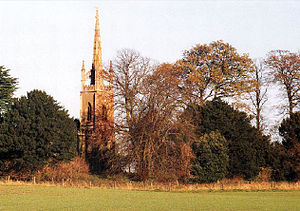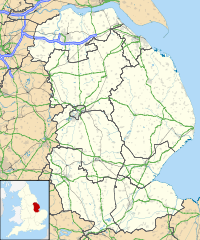- All Saints Church, Haugham
-
All Saints Church, Haugham 
Tower and spire of All Saints Church, HaughamLocation in Lincolnshire Coordinates: 53°18′46″N 0°00′12″E / 53.3127°N 0.0034°E OS grid reference TF 330 810 Location Haugham, Lincolnshire Country England Denomination Anglican Website Churches Conservation Trust Architecture Functional status Redundant Heritage designation Grade II* Designated 9 March 1967 Architect(s) W. A. Nicholson Architectural type Church Style Gothic Revival Groundbreaking 1837 Completed 1840 Specifications Materials Rendered brick and green sandstone rubble
Roofs slatedAll Saints Church, Haugham, is a redundant Anglican church in the village of Haugham, Lincolnshire, England. It has been designated by English Heritage as a Grade II* listed building,[1] and is under the care of the Churches Conservation Trust.[2] The church stands on the southwestern edge of the village, 4 miles (6 km) south of Louth, to the west of the A16 road.[2][3]
Contents
History
The church was built between 1837 and 1840 on the site of an earlier church,[2] and was designed by W. A. Nicholson.[1] It was declared redundant in May 1981.[4]
Architecture
Exterior
All Saints is constructed in rendered brick and green sandstone rubble. The roofs are slated.[1] It is a small church seating only about 80 people.[4] Its plan consists of a nave with a south porch, a chancel, and a west tower with a spire. The whole church stands on a plinth. The tower is supported by diagonal buttresses, and has a pointed west window with two lights. There are two-light pointed bell openings on each side. The parapet consists of pierced battlements containing tracery, and it has ornate corner pinnacles. The tower is surmounted by a recessed octagonal spire, supported by ornate flying buttresses, and is decorated with crockets.[1] The spire is said to echo the similar but larger spire of St. James Church in Louth.[2][5]
Along the north side of the nave are three two-light pointed windows, alternating with four buttresses that are surmounted by ornate pinnacles. Along the top of the nave are moulded eaves and battlements. In the north wall of the chancel is a single narrow pointed window. At the east end are angle buttresses with pinnacles, and a three-light pointed window. Over this is an ornate parapet with a corbel head and a cross finial. The south wall of the chancel has a single narrow window, and in the south wall of the nave are two two-light pointed windows. The porch is gabled and has single-light windows in its east and west sides. It has moulded eaves, an ornate parapet with a finial, and pinnacles.[1]
Interior
Flanking the chancel arch are boards painted with the Ten Commandments, and over the arch are the Royal arms of Queen Victoria.[1][2] The pews date from the 19th century, and are carved with poppyheads. There are two box pews, one of which incorporates the pulpit and the lectern. The choir stalls, altar rail and reredos are all from the 19th century, as is the stained glass, which includes a copy of The Light of the World by Holman Hunt.[1] There are some older fittings moved from the previous church.[5] These date from the 15th century, and are an octagonal font, and another smaller font or a stoup. The memorials date from the 18th and 19th centuries.[1]
See also
- List of churches preserved by the Churches Conservation Trust in the East of England
References
- ^ a b c d e f g h "Church of All Saints, Haugham", The National Heritage List for England (English Heritage), 2011, http://list.english-heritage.org.uk/resultsingle.aspx?uid=1063691, retrieved 16 May 2011
- ^ a b c d e All Saints' Church, Haugham, Lincolnshire, Churches Conservation Trust, http://www.visitchurches.org.uk/Ourchurches/Completelistofchurches/All-Saints-Church-Haugham-Lincolnshire/, retrieved 25 March 2011
- ^ Haugham, Streetmap, http://streetmap.co.uk/grid/533455_381431_120, retrieved 10 March 2011
- ^ a b Haugham: Church History, GENUKI, http://www.genuki.org.uk/big/eng/LIN/Haugham/#ChurchHist, retrieved 10 March 2011
- ^ a b Haugham, All Saints Church, Britain Express, http://www.britainexpress.com/attractions.htm?attraction=4064, retrieved 10 March 2011
Categories:- Grade II* listed buildings in Lincolnshire
- Grade II* listed churches
- Church of England churches in Lincolnshire
- Gothic Revival architecture in England
- Religious buildings completed in 1840
- Churches preserved by the Churches Conservation Trust
Wikimedia Foundation. 2010.

